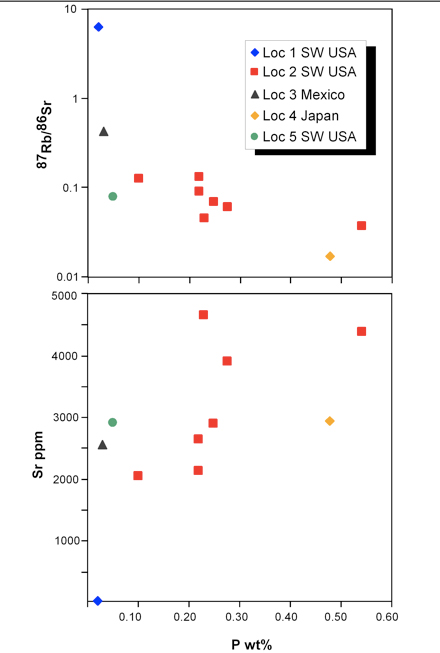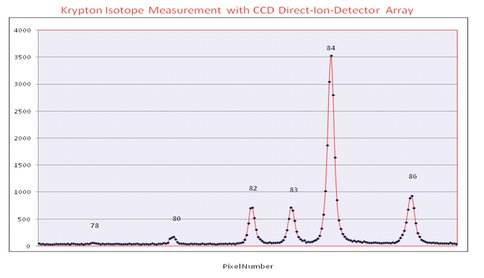2009 Annual Science Report
 University of Wisconsin
Reporting | JUL 2008 – AUG 2009
University of Wisconsin
Reporting | JUL 2008 – AUG 2009
Laser Ablation-Electron Impact Ionization-Miniature Mass Spectrometer (LA-EI-MMS) for In-Situ Geochronology and Hydrology of Martian Rocks
Project Summary
Geochronologic investigations of Mars have focused exclusively on Martian meteorites and crater counting the Martian surface to infer relative ages of different Martian surfaces. Our goal is to develop geochronologic methods that can be applied using a miniature mass spectrometer capable of being deployed on a Mars rover to perform chemical and Rb-Sr isotope analysis on samples collected from the Martian surface. In parallel with instrument development we are conducting terrestrial studies of Martian analog materials and SNC meteorites to develop standards for the miniature mass spectrometer and methodologies for interpretation of data that may be collected using this miniature mass spectrometer.
Project Progress
We are pursuing three aspects: 1) evaluation of the miniature mass spectrometer’s capability for Rb-Sr isotope analysis, 2) development of Rb-Sr mineral standards to calibrate the miniature mass spectrometer, and 3) conduct geochronologic studies on SNC meteorites and terrestrial martian analogs to develop information needed for interpreting miniature mass spectrometer data once it is deployed on a mission.
Instrument capabilities: We have evaluated the potential of the miniature mass spectrometer to measure isotope composition over the Sr mass range (mass 84-88) by analysis of Kr. Krypton gas has been used because it can be inlet into the miniature mass spectrometer without laser ablation and thus allows us to fully document the capability of the mass spectrometer and modified CCD detector array. The Kr mass scan is shown in figure 1.
The ratios of the measured intensities of the isotopes of Kr with the intensity of 84Kr are listed in table 1 and are compared with the true isotope ratios of Kr as determined by IRMM.
Figure 1. Figure 1: Plot of relative ion intensity versus mass of Kr gas
Calculations show that small differences in the measured values with the IRMM values are not due to instrumental mass bias or abundance sensitivity issues. Rather, these differences arise from the slight gain variations differences in the gain between different pixels of the modified CCD detector array. Such gains can be easily corrected by normalization to a standard with known isotope composition which is the subject of the ongoing work.
Terrestrial Martian analog materials: Our ongoing work on developing Martian analog materials follows two main avenues of work: 1) development of mineral Rb-Sr isotope standards and 2) evaluate the usefulness of the mineral jarosite for Rb-Sr geochronology.
Mineral Standard Development: Potential mineral standards are initially screened using back scattered electron images of gain mounts. If samples are chemically homogenous multiple mineral grains from the sample are analyzed for their Rb-Sr isotope compositions to evaluate isotopic homogeneity using thermal ionization mass spectrometry with Rb-Sr concentrations determined by isotope dilution mass spectrometry. Our initial work is to evaluate a series of feldspars including 4 K-feldspars (2 sanidine, 1 microcline, 1 orthoclase) and 5 plagioclase standards (1 albite, 2 oligoclase, 1 labradorite, and 1 anorthite). These samples have been characterized by SEM BSE work and are being analyzed for their Sr isotope compositions and Rb-Sr concentrations.
Potential of Jarosite for Rb-Sr Geochronology: The discovery of jarosite at Meridiani Planum by the Mars rover Opportunity has highlighted the importance of this phase in elucidating the past climatic history or Mars. The presence of this mineral, and other phases, documents that the Meridiani Planum setting was at one time an ancient lake bed and the fluids that precipitated some of the minerals must have been acidic. The timing of these wet conditions is unknown although based on the relative age of geomorphic features the sedimentary rocks disconformably overlie middle to late Noachian terranes, implying the sedimentary rocks could be several billion years old. Geochronology studies conducted on this material will likely establish when these wet conditions existed on Mars.
Age dating of terrestrial jarosite group minerals has been primarily done using the K-Ar system and has been used to determine the time jarosite precipitated from aqueous solutions, the time of weathering, and when epithermal vein formation or supergene alteration in ore deposits has occurred. It has been hypothesized that jarosite will be suitable for Rb-Sr isotope geochemistry based on the fact that Rb should behave like K and thus these phases are likely to have high Rb/Sr ratios. However, the Rb-Sr systematics of this mineral group has not been investigated and it is unknown what controls Rb-Sr substitution in this mineral. Jarosite KFe3(SO4)2(OH)6 is part of the alunite mineral group characterized by general formula (AB3(XO4)2(OH)6, where A is typically a monovalent cations such as K+, Na+, Rb+, but can include divalent cations such as Ca2+, Ba2+, Sr2+. The B site typically is a trivalent cations such as Fe3+or Al3+,but divalent cations such as Pb2+, Zn2+, Mg2+, exist as well. The X site is an anion complex that is typically S, P, or As and it is thought that the charge of this anion complex (e.g., PO4 3- for SO4 2-) is critical in the charge balanced substitution of divalent cations in the A site.
We are conducting a survey of jarosite group minerals from a variety of localities to determine their Rb-Sr isotope compositions by TIMS and to evaluate the crystal chemical controls on their Rb-Sr concentrations by electron microprobe analysis. To date we have analyzed 11 jarosite samples from 5 different world-wide localities, for their major element composition (determined by electron microprobe EMP) and Rb-Sr concentrations and Sr isotope compositions. Analysis by TIMS and EMP reveals that there is a positive correlation between P and Sr concentrations

Figure 2. Figure 2: Plot of measured 87Rb/86Sr (upper figure) and Sr concentration (lower figure) versus P concentration measured in jarosite samples from different worldwide locations. Jarosite that is most amenable to Rb-Sr geochronology have low P concentration which appears to control the substitution of Sr into the K cation site in the jarosite mineral structure.
supporting the idea that Sr substitutes into the A site via a coupled charge substitution mechanism with a lower charged cation in the X site. This substitution mechanism implies that jarosite will have high 87Rb/86Sr if P concentration is low (Figure 2) and thus some jarosite is well suited for Rb-Sr geochronology.
Martian Geochronology:
The geochronology of SNC meteorites is complicated by their protracted history that includes crystallization of the rocks from an igneous melt, Martian alteration/weathering processes, shock metamorphism by the impactor that knocked the material off of Mars, space weathering, and low temperature terrestrial weathering. Our laser ablation technique will avoid many of these problems because samples can be analyzed from the Martian surface and thus avoid the metamorphic and alteration processes associated with transporting Martian material to earth via impact processes. Moreover, because the laser ablation of neutral atoms is a spot analysis technique it will be possible to avoid highly altered minerals. Never the less, it is important to document how Martian alteration affects mineral isochrons using a variety of geochronometers. Most previous geochronology on SNC meteorites has focused on using the Sm-Nd and Rb-Sr isotope systems and in general workers consider an isochron to have merit when both systems yield the same age. However, these best fit isochrons typically involve selective leaching of mineral separates and even sometimes selecting only some of the minerals to fit the isochron. These issues are largely a result of phosphatic phases containing a significant amount of the parent isotope (e.g., Sr or Nd). Phosphatic phases are susceptible to selective dissolution in acidic environments that are common on Mars and thus Martian acidic alteration can have an impact on the inferred age. In contrast to the Sm-Nd and Rb-Sr systems the Lu-Hf system is not affected by alteration of phosphates like the Rb-Sr and Sm-Nd systems because Hf is not strongly portioned into phosphates.
The Lu-Hf system allows one to gain a different perspective on SNC geochronology and we determined 4 Lu-Hf isochrons on 4 Martian meteorites that include 3 shergottites (RBT-0462, NWA4468, LAR 06319; 225 ±21 Ma; 179 ±27, and 197 ±29 Ma, respectively, Lapen et al, 2008; 2009; Shafer et al., 2009) and the oldest Martian meteorite ALHA84001 (4086 ±30 Ma; Righter et al., 2009; from an astrobiological point of view ALH84001 is one of the most important samples yet recognized for activating the scientific community to develop methods to identify past biogenic activity). The shergottite Lu-Hf ages agree well with Rb-Sr and Sm-Nd ages from these samples and suggest that leaching methods developed by workers for Rb-Sr and Sm-Nd devoted to seeing through Martian alteration are effective. The Lu-Hf age for ALHA84001 is younger than its corresponding internal Sm-Nd age which varies considerably depending upon the combination of leached and unleached bulk sample and minerals that are included in the isochron fit and range from an impossible old age of 4889 to 4450 Ma. The Lu-Hf age agrees well with U-Pb and Ar geochronologic methods and is best interpreted as an igneous crystallization age. The young Lu-Hf age implies that the magnetic field of Mars was active far longer than initially thought because the old Sm-Nd age is more likely a result of Sm-Nd redistribution associated with Martian alteration and does not reflect the antiquity of the sample.
Future work: Our future work will be to begin Sr isotope analysis via laser ablation starting with using Sr rich samples that include celestite (SrSO4), strontianite (SrCO3) and a Sr rich silicate such as plagioclase. We will also continue conducting analyses of jarosite to identify the potential of this phase for possible Sr geochronology; this work will focus on collecting jarosite samples that formed in lacustrine settings.
Publications
- Lapen, T.J., Brandon, A.D., Beard, B.L., Peslier, A.H., Lee –T, A. & Dalton, H.A. (2008). Lu-Hf age of isotope systematics of the olivine-phyric shergottite RBT-04262 and implications for the sources of enriched shergotitites. Lunar Planetary Sci.
- Lapen, T.J., Righter, M., Brandon, A.D., Beard, B.L., Shafer, J. & Irving, A.J. (2009). Lu-Hf isotope systematics of NWA4468 and NWA2990: Implications for the sources of shergottites. Lunar Planetary Sci.
- Righter, M., Lapen, T.J., Brandon, A.D. & Beard, B.L. (2009). Lu-Hf age of isotope systematics of ALH84001. Lunar Planetary Sci.
- Shafer, J.T., Brandon, A.D., Lapen, T.J., Righter, M., Beard, B. & Peslier, A.H. (2009). Lu-Hf age of martian meteorites Larkman Nunatek 06319. Lunar Planetary Sci.
-
PROJECT INVESTIGATORS:
-
PROJECT MEMBERS:
Clark Johnson
Co-Investigator
Jim Ludois
Co-Investigator
John Fournelle
Collaborator
Tom Lapen
Collaborator
Amalia Doebber
Graduate Student
-
RELATED OBJECTIVES:
Objective 2.1
Mars exploration.


